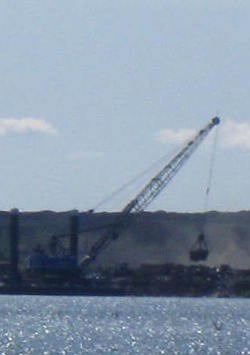Essar Steel Algoma Inc. has been dredging this month at Saw Mill Point on the upper St. Marys River.
The company is building a new deep water dock at that location because there's currently insufficient draft at the Essar slip for most lake freighters to carry to capacity.
Chief Operating Officer Armando Plastino says dredging began late last month.
"The application process was facilitated by the [Sault Ste. Marie Region] Conservation Authority Conservation and involved consultation with four different ministries (Ontario Ministry of the Environment, Ontario Ministry of Natural Resources, Transport Canada, Fisheries and Oceans Canada) and the First Nations," says Brenda Stenta, Essar's manager of corporate communications.
"The dredging contractor, Purvis Marine, has acquired new, state-of-the-art dredging equipment that provides for less sediment disturbance and features global positioning system (GPS) devices on the hoist. allowing for very accurate, targeted dredging," says Stenta.
A permit to begin dredging on the upper St. Mary's River was issued to Essar Steel Algoma on June 17, says Sault Ste. Marie Region Conservation Authority Assistant Manager Christine Aasen.
Essar is using silt curtains to ensure any sediment that may be disturbed will not be carried downstream.
They are disposing of the dredged material in an approved landfill located on Essar property.
"Because of the nature of the river and its currents, some cloudiness should be expected," says Aasen.
The permit, issued through a new one-stop-shopping process, included comments and input from all three levels of government and all appropriate agencies within those governments.
Essar Steel Algoma asked to dredge 89,000 cubic metres of sediment from its slip on the upper St. Marys River because of dropping water levels, rising shipping and receiving demands and expected production increases, Aasen said.
The St. Marys River was designated an area of concern - a location where environmental quality is significantly degraded and beneficial uses to humans and wildlife are impaired - by the International Joint Commission in the early 1990s.
Since that time, several intergovernmental agreements have been struck to clean up the river and protect it from further environmental damage.
Subsequent studies by the Minstry of the Environment found that historical contamination of the river by at least five point and several non-point sources resulted in sediments becoming contaminated with toxics such as arsenic, cadmium, chromium, copper, cyanide and lead.
Some efforts have been made to clean up the river, including the area around the Essar boat slip, over the past three years.
Also, significant efforts to reduce contaminant loading from identified point-sources such as the steel and paper mils and waste water treatment facilities on both sies of the river have resulted in noticeably decreased contamination concentrations in the river since monitoring began in earnest in the 1960s.
Another condition placed on Essar's permit to dredge requires the company to test and monitor the contents of sediment it dredges over the coming weeks.
At the conclusion of the project, the company will release its results to the Ministry of the Environment.
For more information on the St. Marys River Remedial Action Plan, visit its page on the Sault Ste. Marie Region Conservation Authority website or the St. Marys River Area of Concern page on the U.S. Environmental Protection Agency website.
